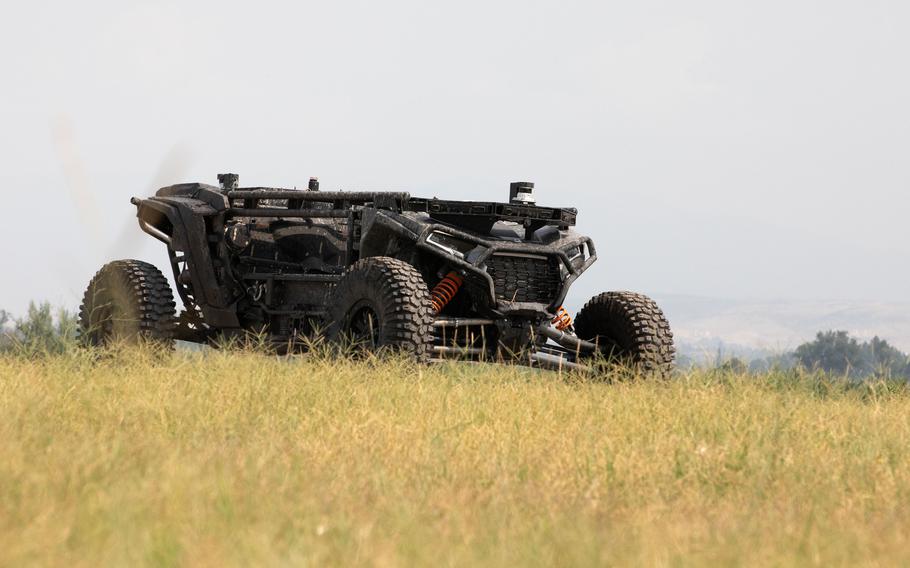
Seattle-based tech company Overland AI demonstrates its fully autonomous tactical vehicle Ultra at Vaziani Training Area in Georgia with U.S. soldiers from 1st Squadron, 91st Cavalry Regiment, 173rd Airborne Brigade, July 29, 2025, during exercise Agile Spirit. (Cameron Boyd/U.S. Army)
GRAFENWOEHR, Germany — When a U.S. Army airborne unit was resupplied during a recent live-fire exercise in the Caucasus, there was something notably absent from the delivery vehicle: a driver.
The soldiers, from the Grafenwoehr-based 1st Squadron, 91st Cavalry Regiment (Airborne), used a prototype of a fully autonomous tactical vehicle called the Ultra to see how the Army might roll as its revamped fighting doctrine continues to take shape.
“There’s a ton of potential here and we’re excited to keep testing it,” squadron commander Lt. Col. Austin Commons said Monday, just after the end of Agile Spirit, a biennial exercise that this year was held in Turkey and Georgia.
The Vaziani Training Area in Georgia hosted what Commons said was the Ultra’s first test in field conditions. It traversed a couple of miles of varied terrain using cameras, infrared and lidar to resupply 60 mm and 120 mm mortars.
Most of the live-fire training occurred during a force-on-force exercise with a Georgian opposition on Aug. 1 and Aug. 2, Commons said.
The flat-topped, four-wheeled vehicle can carry about 1,000 pounds and reach speeds up to 35 mph, according to a fact sheet on the website of its manufacturer, Seattle-based defense contractor Overland AI.
Its 72-inch width and all-terrain tires allow it to navigate challenging weather conditions and rough ground.
The Ultra can be programmed for autonomous travel on a preordained route or maneuvered with a handheld controller, said Spc. Jack Padberg, a mortarman from the squadron. Its lidar lasers measure distances and map objects so it can steer clear of obstacles.
For Agile Spirit, the mortarmen selected a series of checkpoints where the vehicle could pick up supplies. They detailed off-limits areas and advised it whether to use roads or move over land. It picked up about 20 mortar rounds and then returned.
“Anytime you’re mobile, you’re not camouflaged,” Padberg said. “You’re a lot easier to spot, especially from the air.”
The Ultra had made that a “non-issue,” he added, because they no longer had to leave their hiding spot for supplies.
Battlefield innovations like the Ultra further illustrate Army efforts to introduce robots and autonomous vehicles to take the pressure off front-line units and improve the odds of keeping soldiers alive amid sea changes in how wars are waged.
In 2024, the service updated its combat doctrine with Transforming in Contact, which emphasizes rapid movement, deception, adaptability and, most importantly, technology like drones.
It is rooted in lessons the U.S. military has drawn from the Russia-Ukraine war, which has been marked by novel uses of various aerial and sea drones. Padberg said using the Ultra was like seeing the future.
About 800 U.S. service members took part in Agile Spirit, which ran from July 21 to Friday, an Army statement said. It included 2,000 soldiers from 10 countries including Poland, Germany and Ukraine.
The Ultra tested by the soldiers from Grafenwoehr performed admirably, Padberg said, though it did mistake some thick shrubs for trees and refused to go through them. But the controller let the soldiers bypass that problem with ease, Padberg said.
Overland AI will use the data from the Georgia exercise to improve the vehicle for further testing.